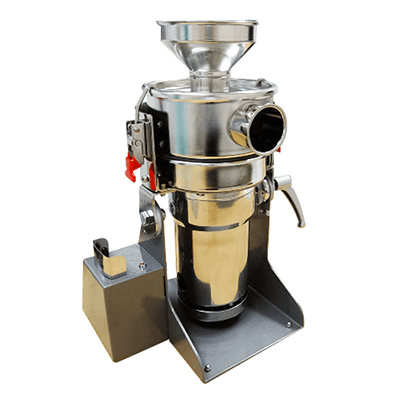What Is a Pulverizer?

Pulverizers are equipment that can grind and process fine particles down to a few micrometers in size.
By applying energy to a solid material of a certain size, the material is crushed into a fine powder. Depending on the size of the particles to be pulverized, the different stages of pulverization are distinguished as coarse and medium pulverization.
Since the properties of the powder vary depending on its particle size, it is important to select a pulverizer based on the uniformity of the particle size and the unit of milling.
There are various methods of adding energy to pulverizers, such as roller mills, jet mills, high-speed rotary mills, and container-driven mills.
Uses of Pulverizers
Pulverizers are used to reduce the substance to be processed to a powder form and a uniform particle size.
In industrial and other production settings, pulverization has the advantage of increasing the efficiency of the processing process by increasing the surface area of the individual solid particles as they become finer. It is also possible to finely grind materials that contain multiple components, making it possible to select and extract only the necessary components.
Examples of processed materials that can be finely milled include metals such as alumina and nickel, resins, chemicals, and pharmaceuticals.
Principle of Pulverizers
There are two types of pulverization: surface pulverization, in which the surface of a material is scraped by friction or other means to reduce it from fragments to smaller and smaller particles; and volumetric pulverization, in which the entire material is divided into larger and smaller particles by the application of force and gradually becomes smaller.
In practice, milling occurs when these two types of milling are combined. From the beginning, solid materials have small cracks or defects in their inner structure. When an external force is applied, it affects these partial defects and causes a major breakdown, leading to pulverization.
The mills can change the way energy is applied. Roller mills use gravity or centrifugal force of rollers to apply energy by pressing them against a rotating container, which compresses and crushes the material. In a jet mill, gas is injected at high pressure through a jet nozzle, and particles collide with each other in the jet stream to add energy and pulverize by friction and impact.
Types of Pulverizers
The following seven types of pulverizers are typical.
1. Roller Mill
Roller mills consist of several rollers whose gravity and centrifugal force press against a rotating table or bowl-shaped grinding vessel, compressing and pulverizing the sandwiched materials.
2. Jet Mill
Air, steam, or gas is jetted out from a nozzle at a pressure of several atmospheres or higher to accelerate the material particles, which are crushed by collision and impact.
3. Hammer Mill
A hammer rotating at high speed impinges on the feed particles to pulverize them. A perforated plate, screen, or grit is placed at the outlet to control the particle size of the milled product as a so-called screen mill.
4. Pin Mill
Dozens of pins are planted on the surfaces of two facing disks so that they engage each other. One or both disks are rotated at high speed to feed crushed material to the center of the disks, where it is crushed by the impact and shearing forces of the pins as it moves in a circumferential direction under centrifugal force.
5. Rotary Mill
A rotating cylinder with a horizontal axis is filled with a grinding medium (balls, rods, etc.) that fills 1/3 of its volume and crushes the material by rotating the cylinder.
6. Vibrating Mill
A cylindrical or trough-shaped mill is filled with balls or other grinding media.
7. Planetary Mill
The container filled with balls and crushed material is rotated by a mechanism in which the balls and crushed media rotate on their axis while the container orbits on its axis.